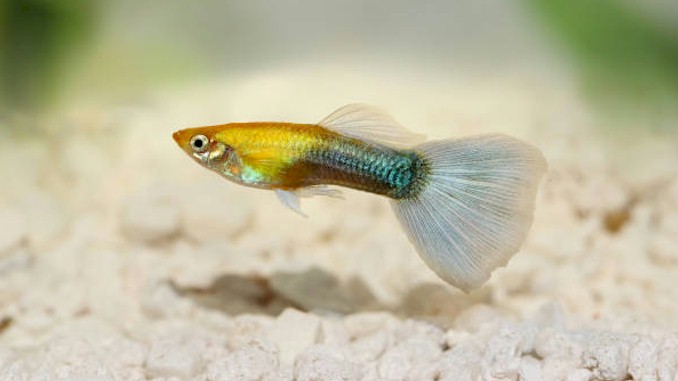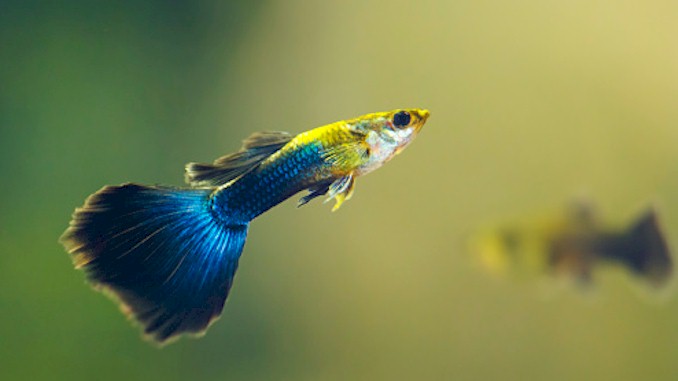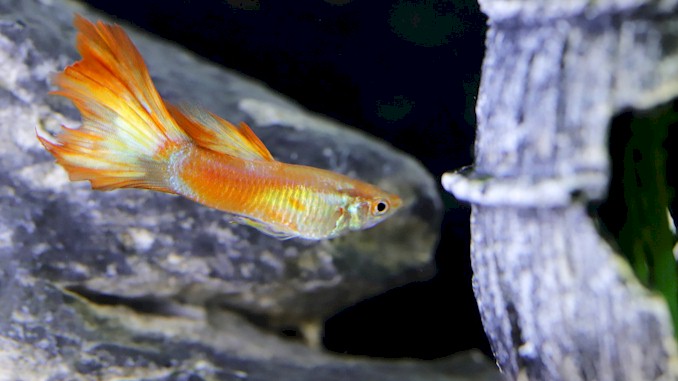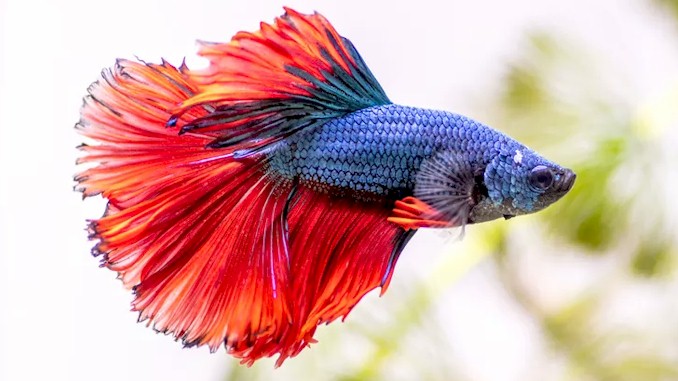Exotic, Colorful, and Unique: Meet the Rare Guppy Breeds You Never Knew Existed
As an avid fish enthusiast, I have spent years studying and breeding guppies of all types. Through my extensive experience, I have come across some truly rare and unique guppy breeds that I am excited to share with you. In this blog post, I will showcase some of the most elusive and beautiful guppies that you may have never seen before. With detailed descriptions and high-quality pictures, I aim to provide you with all the information you need to know about these rare guppy breeds. Whether you are a seasoned fishkeeper or a beginner, I am confident that this post will leave you in awe and inspire you to add these stunning fish to your collection.
Among the rare guppy breeds are the Albino Full Red Guppy, Blonde Tuxedo Guppy, Cobra Guppy, Electric Blue Guppy, Metal Lace Guppy, Half-Black Green Guppy, Dumbo Ear Guppy, Real Red Eye Guppy, Purple Moscow Guppy, each with their distinct coloration and patterns. These rare guppy breeds are highly sought after by collectors and hobbyists alike, and their beauty and rarity make them a fascinating addition to any aquarium.
If you’re interested in learning more about rare guppy breeds, you’re in luck! In the following paragraphs, I will provide in-depth information on each of these rare guppy breeds, including their origins, unique characteristics, and tips on how to care for them. Additionally, I will highlight some lesser-known rare guppy breeds that are equally as beautiful and captivating. So, whether you’re a seasoned guppy enthusiast or simply curious about these rare breeds, keep reading to discover some of the most exquisite guppies that you may have never seen before.
The Blonde Tuxedo Guppy: A Golden Gem of the Guppy World
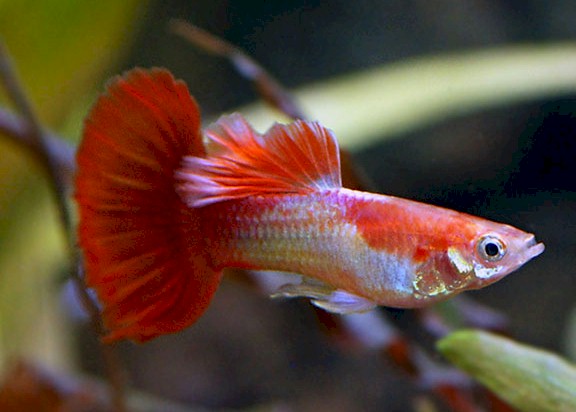

The Blonde Tuxedo Guppy is a rare and unique guppy breed with a striking golden body and black tail. This beautiful guppy is a variation of the Tuxedo Guppy, a popular guppy breed known for its contrasting body and tail coloration. The Blonde Tuxedo Guppy is highly sought after by guppy enthusiasts and collectors due to its rare and beautiful appearance.
One of the most striking features of the Blonde Tuxedo Guppy is its golden body color. This coloration is caused by a genetic mutation that affects the pigments responsible for producing color in the guppy’s scales. This mutation causes the guppy’s scales to appear gold rather than the typical silver or gray coloration seen in other guppies. The black tail of the Blonde Tuxedo Guppy provides a beautiful contrast to the golden body, making this guppy breed a true gem in the guppy world.
In addition to its unique appearance, the Blonde Tuxedo Guppy is also known for its hardiness and ease of care. This guppy breed is adaptable to a wide range of water conditions and can thrive in a variety of aquarium setups. However, like all guppies, the Blonde Tuxedo Guppy requires a balanced and nutritious diet to maintain its health and vibrant coloration.
If you’re interested in adding a rare and beautiful guppy to your aquarium collection, the Blonde Tuxedo Guppy is definitely worth considering. Not only is this guppy visually stunning, but it is also easy to care for and adaptable to a range of environments. With its unique golden body and black tail, the Blonde Tuxedo Guppy is sure to be a standout addition to any aquarium.
Electric Blue Guppy: A Striking and Rare Variety


The Electric Blue Guppy is a stunning and rare variety of guppy known for its vibrant blue coloration. This guppy breed is highly sought after by collectors and enthusiasts due to its striking appearance and relative rarity. In this section, we’ll delve deeper into the characteristics and care requirements of the Electric Blue Guppy.
One of the most notable features of the Electric Blue Guppy is its stunning blue coloration. The body and fins of this guppy are a deep and vibrant shade of blue, which makes it a popular choice for those looking to add a splash of color to their aquariums. The Electric Blue Guppy is also known for its large dorsal fin, which adds to its visual appeal.
While the Electric Blue Guppy is a relatively rare breed, it can be found in some specialty fish stores and online retailers. Due to its popularity, however, it can sometimes be difficult to find Electric Blue Guppies for sale. If you are interested in adding this striking guppy to your collection, it is important to do your research and ensure that you are purchasing from a reputable seller.
In terms of care requirements, the Electric Blue Guppy is similar to other guppy breeds. These fish require a well-maintained aquarium with a balanced and nutritious diet. They also prefer water that is slightly alkaline and a temperature range of 72-82°F. A filtration system and regular water changes are also important for maintaining the health and wellbeing of the Electric Blue Guppy.
Breeding Electric Blue Guppies can be challenging, as this is a relatively rare variety and obtaining breeding stock can be difficult. However, with patience and dedication, it is possible to successfully breed these guppies. It is important to note that inbreeding should be avoided, as this can lead to genetic defects and health issues.
A uncommon and eye-catching kind of guppy, the Electric Blue Guppy will undoubtedly offer aesthetic appeal to any aquarium, to sum up. This particular guppy breed is highly sought after by collectors and enthusiasts because to its vivid blue coloring and huge dorsal fin. Make sure to complete your homework and give the unusual and uncommon guppy the attention it need to thrive if you’re interested in adding it to your collection.
Metal Lace Guppy: An Elegant and Unique Guppy Breed
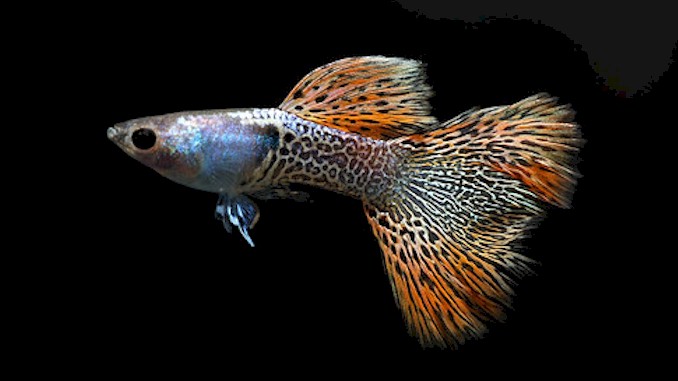

The Metal Lace Guppy is a stunning and unique variety of guppy that is known for its distinctive metallic scales and lace-like patterns. This guppy breed is highly sought after by collectors and enthusiasts due to its elegant appearance and relative rarity. In this section, we’ll take a closer look at the characteristics and care requirements of the Metal Lace Guppy.
One of the most striking features of the Metal Lace Guppy is its metallic scales, which give it a shimmering and iridescent appearance. These scales can range from gold and silver to copper and bronze, depending on the specific strain of Metal Lace Guppy. In addition to its metallic scales, this guppy breed is also known for its lace-like patterns, which can vary in color and intensity.
The Metal Lace Guppy is a relatively rare breed, and obtaining breeding stock can be challenging. However, with patience and dedication, it is possible to successfully breed these guppies. It is important to note that inbreeding should be avoided, as this can lead to genetic defects and health issues.
In terms of care requirements, the Metal Lace Guppy is similar to other guppy breeds. These fish require a well-maintained aquarium with a balanced and nutritious diet. They also prefer water that is slightly alkaline and a temperature range of 72-82°F. A filtration system and regular water changes are also important for maintaining the health and wellbeing of the Metal Lace Guppy.
It is worth noting that the Metal Lace Guppy can be more sensitive to water conditions than some other guppy breeds, and may be more prone to stress and disease if the water quality is not carefully maintained. It is important to monitor the water chemistry regularly and make adjustments as needed to ensure that the Metal Lace Guppy remains healthy and happy.
In short, the Metal Lace Guppy is a distinct and gorgeous guppy breed that will stand out in any aquarium. This guppy breed is highly sought after by collectors and enthusiasts due to its sparkling metallic scales and lace-like patterns. If you want to add this unusual and special guppy to your collection, do your research and offer it all the care it need to flourish.
Bronze Guppy: A Timeless Classic
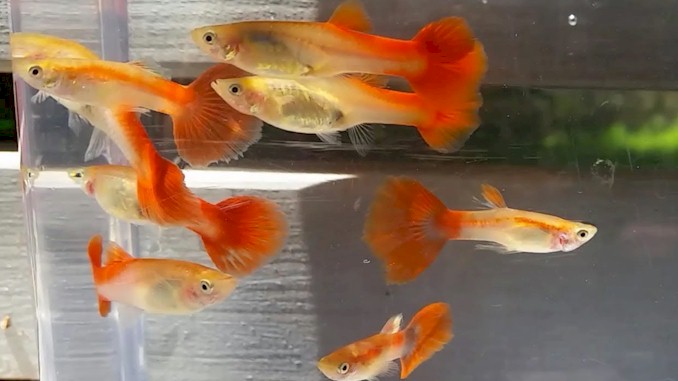

The Bronze Guppy is a classic and timeless variety of guppy that has been popular among aquarium enthusiasts for many years. As its name suggests, this guppy breed is characterized by its bronze-colored scales, which give it a warm and inviting appearance. In this section, we’ll take a closer look at the characteristics and care requirements of the Bronze Guppy.
One of the most notable features of the Bronze Guppy is its bronze-colored scales, which can range in shade from light to dark depending on the specific strain of guppy. These scales are typically accented by iridescent highlights, which add depth and dimension to the guppy’s appearance. In addition to its bronze scales, the Bronze Guppy is also known for its long, flowing fins, which can be transparent or colored.
The Bronze Guppy is a hardy and resilient breed that is relatively easy to care for. These fish prefer water that is slightly alkaline and a temperature range of 72-82°F. A well-maintained aquarium with a balanced and nutritious diet is also important for maintaining the health and wellbeing of the Bronze Guppy.
Breeding the Bronze Guppy is relatively straightforward, and this guppy breed is known for its prolific breeding habits. However, it is important to avoid inbreeding, as this can lead to genetic defects and health issues. Additionally, it is important to provide the fry with plenty of hiding places and vegetation to help them survive.
In terms of temperament, the Bronze Guppy is generally peaceful and gets along well with other fish of similar size and temperament. However, it is important to keep in mind that male guppies can be aggressive towards each other, especially when competing for females. Providing plenty of hiding places and breaking up the line of sight within the aquarium can help to reduce aggression among male guppies.
In summary, the Bronze Guppy is a classic and timeless variety of guppy that is sure to make a beautiful addition to any aquarium. With its warm and inviting bronze-colored scales and long, flowing fins, this guppy breed is a popular choice among collectors and enthusiasts. If you are interested in adding the Bronze Guppy to your collection, be sure to provide it with a well-maintained aquarium, a balanced and nutritious diet, and plenty of hiding places to help it thrive.
Albino Full Red Guppy: A Rare Beauty with Unique Genetics


The Albino Full Red Guppy is a truly stunning fish with a striking coloration that sets it apart from other guppy breeds. As the name suggests, this guppy is an albino variation with a full red color that covers its entire body. This unique coloration is due to a combination of recessive genes that create an impressive visual display.
Unlike other guppies that have black or dark-colored eyes, Albino Full Red Guppies have bright red eyes, adding to their beauty and allure. Interestingly, the Albino Full Red Guppy is the result of a genetic mutation that occurred naturally in the wild, and the selective breeding of these fish has led to the creation of more stable and predictable strains.
One of the most fascinating things about Albino Full Red Guppies is their genetics. The red coloration of these guppies is created by a combination of two recessive genes, which means that both parents must carry these genes to produce offspring with this coloration. This can make breeding Albino Full Red Guppies a bit tricky, as both parents need to have the correct genetics to produce offspring with the desired traits.
If you’re lucky enough to breed Albino Full Red Guppies successfully, you can expect to have a beautiful and rare addition to your aquarium. These guppies are highly sought after by collectors and hobbyists due to their unique coloration and rarity. However, it’s important to note that Albino Full Red Guppies require the same care as other guppy breeds, including a balanced diet, clean water, and a suitable environment.
In conclusion, the Albino Full Red Guppy is a fascinating and beautiful fish that is sure to capture the attention of any aquarium enthusiast. With their unique coloration and genetics, these rare guppies are a testament to the diversity and beauty of the guppy world.
The Cobra Guppy: A Striking and Distinctive Breed


The Cobra Guppy is a unique and striking guppy breed known for its distinctive coloration and pattern. This guppy breed is named for its resemblance to a cobra snake, with its dark and bold markings that run along the body and fins. The Cobra Guppy is a popular choice among guppy enthusiasts due to its bold appearance and ease of care.
One of the most notable features of the Cobra Guppy is its distinct coloration and pattern. The body of the Cobra Guppy is typically a light color, such as silver or gold, with dark and bold markings that run along the length of the body and fins. These markings resemble the stripes of a cobra snake and give the Cobra Guppy its unique and striking appearance.
The Cobra Guppy is also known for its ease of care and hardiness. This guppy breed is adaptable to a range of water conditions and can thrive in a variety of aquarium setups. The Cobra Guppy is also relatively easy to breed, making it a popular choice for both beginner and experienced guppy breeders.
Like all guppies, the Cobra Guppy requires a balanced and nutritious diet to maintain its health and vibrant coloration. A diet that includes high-quality flake food, as well as live and frozen foods, is recommended to keep these guppies in top condition. Additionally, regular water changes and proper filtration are important for maintaining the health and wellbeing of the Cobra Guppy.
As you have learned, the Cobra Guppy is a distinctive and striking guppy breed that is sure to add visual interest to any aquarium. With its bold markings and ease of care, this guppy breed is a popular choice among guppy enthusiasts and collectors. If you’re looking to add a unique and visually stunning guppy to your aquarium collection, the Cobra Guppy is definitely worth considering.
Half-Black Green Guppy


The Half-Black Green Guppy is a beautiful and unique breed that is highly sought after by fish enthusiasts. This breed is so named because of its half-black and half-green coloring. The half-black color is caused by a genetic mutation that affects the melanin pigment in the fish’s body, while the green color is produced by iridophores in the skin.
Half-Black Green Guppies are relatively easy to care for and can be kept in a variety of tank sizes. They prefer slightly alkaline water with a pH of around 7.2 and a temperature range of 72-82°F. These fish are omnivores and will eat a variety of foods, including flakes, pellets, and live or frozen foods.
One of the unique features of Half-Black Green Guppies is their ability to change color based on their environment. For example, if they are kept in a tank with a dark substrate, their black coloration may become more prominent. If they are kept in a tank with green plants, their green coloration may become more vibrant.
When breeding Half-Black Green Guppies, it is important to select healthy, high-quality fish with desirable traits. Males are typically more colorful than females and will display their fins and tails to attract mates. Females can give birth to up to 50 fry at a time and will often hide their offspring in plants or other hiding places to protect them from other fish.
Overall, the Half-Black Green Guppy is a unique and beautiful addition to any aquarium. With proper care and attention, these fish can thrive and provide hours of enjoyment for their owners.
Grass Tail Guppy: An Uncommon Beauty with Delicate Fins
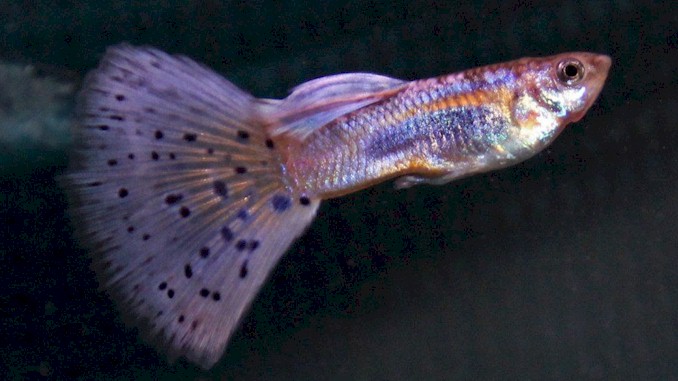

If you’re looking for an uncommon guppy breed that’s both visually stunning and delicate, the Grass Tail Guppy might be the perfect addition to your aquarium. This breed, also known as the Fan Tail Guppy or the Grassfin Guppy, is characterized by its unique tail that appears as a delicate fan-like structure, reminiscent of blades of grass. The tail is usually green or yellow, with a metallic sheen, and can be transparent or opaque.
The Grass Tail Guppy is not as commonly found in pet stores or aquarium shops as some of the other guppy breeds, making it a more exclusive and sought-after addition to any aquarium. Their beauty and rarity make them highly prized by guppy enthusiasts, who enjoy breeding and exhibiting these unique fish.
One of the most striking features of the Grass Tail Guppy is their intricate fins, which are long, flowing, and highly sensitive. These fins can be easily damaged, so it’s important to keep the water quality in the aquarium high and avoid any sharp objects that could harm the fins. In addition, because of their delicate fins, the Grass Tail Guppy is not recommended for aquariums with aggressive fish species that could nip at their tails.
The Grass Tail Guppy is a peaceful and social fish that enjoys swimming in schools, so it’s best to keep them in groups of at least four or more. They are also relatively easy to care for and can thrive in a range of water conditions. They prefer a pH level between 7.0 and 8.5 and a water temperature between 75°F and 82°F. A well-planted aquarium with plenty of hiding spots and open swimming areas is ideal for the Grass Tail Guppy.
In terms of breeding, the Grass Tail Guppy is an oviparous species, which means they lay eggs that hatch after a few days. Breeding can be done in a separate breeding tank or within the community aquarium, as long as there are enough hiding places for the fry to avoid being eaten by other fish. The fry can be fed with a variety of small foods, including crushed flakes or pellets, and should be kept in a separate tank until they are large enough to join the community aquarium.
You see, the Grass Tail Guppy is a unique and beautiful fish that adds a touch of elegance to any aquarium. If you’re looking for a guppy breed that’s uncommon, visually stunning, and relatively easy to care for, the Grass Tail Guppy is an excellent choice. Just be sure to provide them with a safe and peaceful environment, and they’ll thrive and bring joy to your aquarium for years to come.
Dragon Mosaic Guppy
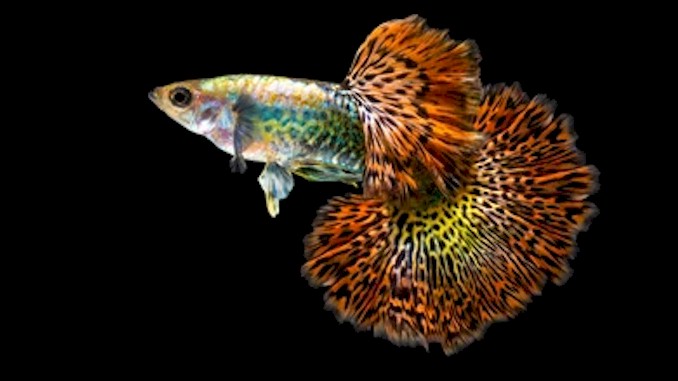

The Dragon Mosaic Guppy is another rare and stunning guppy breed that is highly sought after by hobbyists. This guppy stands out from others due to its unique mosaic pattern, which looks like scales on the fish’s body. The mosaic pattern is created by a genetic mutation that results in dark pigment being deposited in a random pattern on the fish’s body. This creates a unique and striking appearance that is difficult to find in other fish breeds. The Dragon Mosaic Guppy can be found in a variety of colors, including blue, green, and red.
When selecting Dragon Mosaic Guppies, it is essential to choose healthy and active fish. Look for fish with bright, vibrant colors and avoid any fish that appear sluggish or show signs of disease. Males are typically more brightly colored than females, and their dorsal fins are more pronounced. When properly cared for, Dragon Mosaic Guppies can thrive in a community tank and coexist with other peaceful fish species.
One of the advantages of keeping Dragon Mosaic Guppies is that they are relatively easy to care for. They do well in a tank with a temperature range of 72-82°F and a pH range of 6.8-7.8. They are also not picky eaters and will accept a variety of foods, including flake, pellet, and live foods like brine shrimp and bloodworms. However, it’s important to avoid overfeeding, as this can lead to health issues like obesity and swim bladder problems.
When it comes to breeding Dragon Mosaic Guppies, it’s essential to select the right breeding pairs to ensure the continuation of the mosaic pattern. Breeding should be done in a separate breeding tank to prevent aggression from other fish and ensure optimal conditions for the fry. The female will give birth to live fry, which can be raised in a separate fry tank until they reach maturity.
As you see, the Dragon Mosaic Guppy is a rare and unique fish breed that is highly prized by hobbyists. Its distinctive mosaic pattern and vibrant colors make it a standout addition to any aquarium. With proper care and attention, these fish can thrive in a community tank and provide endless enjoyment for their keepers.
Dumbo Ear Guppy
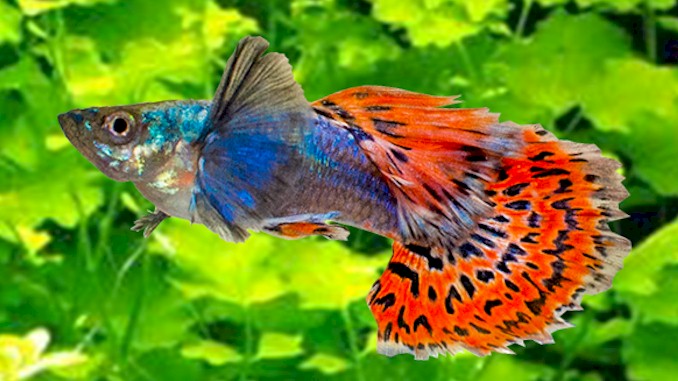

Dumbo Ear Guppies, also known as Elephant Ear Guppies, are a unique and fascinating breed of guppies that are known for their large, oversized pectoral fins that resemble the ears of an elephant. This trait is due to a genetic mutation that causes the fins to grow larger than normal, giving the guppy a distinctive appearance that sets it apart from other guppy breeds.
In addition to their unique appearance, Dumbo Ear Guppies are also known for their peaceful nature and ease of care, making them an ideal choice for both beginner and experienced aquarium hobbyists. They are typically hardy and adaptable to a variety of water conditions, as long as the water is clean and well-maintained.
One of the challenges of breeding Dumbo Ear Guppies is that the large fins can sometimes make swimming and movement difficult for the fish, particularly for males. Therefore, it is important to select breeding pairs carefully and monitor their offspring to ensure that they are healthy and able to swim properly.
Dumbo Ear Guppies are a fascinating and unique addition to any aquarium, and their distinctive appearance and peaceful nature make them a popular choice among aquarium hobbyists. With proper care and attention, these guppies can thrive and provide years of enjoyment for their owners.
What is the rarest guppy in the world?
One of the most common questions that guppy enthusiasts ask is what is the rarest guppy in the world. The answer is not so simple, as there are different ways to define rarity. Some guppies are rare by species classification, meaning they belong to a different species than the common guppy (Poecilia reticulata). Others are rare by strain or breed, meaning they have uncommon or distinctive features that result from selective breeding by hobbyists or researchers.
By species classification, the rarest guppy is probably the swamp guppy (Poecilia wingei). This species was first discovered in 1937 in Venezuela and is closely related to the common guppy. However, it has some unique characteristics that distinguish it from its cousin. For example, it is much smaller (typically less than an inch in size), has a shorter lifespan (about 6 months), and has highly specific water requirements (soft and acidic water with low conductivity). The swamp guppy is also known as the Endler’s livebearer, after John Endler who studied its natural color patterns and behavior.


By strain or breed, the rarest guppy is harder to determine, as there are hundreds of different varieties that have been created by selective breeding over many generations. Some of these strains are highly prized and sought-after by collectors and enthusiasts, while others are endangered or extinct in the wild. Some examples of rare guppy breeds are:
- The Moscow guppy: This breed has a solid color body that can range from blue to purple to black. It also has large fins with contrasting colors or patterns. The Moscow guppy was developed in Russia and is one of the most expensive guppies in the world.
- The Dumbo guppy: This breed has big pectoral fins that resemble the ears of an elephant. It also has a fluid tail with various colors and patterns. The Dumbo guppy was named after Dumbo, the elephant character from Disney’s animated film.
- The Platinum guppy: This breed has a metallic silver body that reflects light like a mirror. It also has bright colored fins that contrast with its body. The Platinum guppy was developed in Japan and is one of the most beautiful guppies in the world.
These are just some examples of rare guppy breeds that have been created by selective breeding over many years. There are many more varieties that have unique features such as color patterns, fin shapes, body sizes or genetic mutations.
Rare guppies are fascinating and attractive fish that can add beauty and diversity to any aquarium. However, they also require more care and attention than common guppies due to their special needs and sensitivities. If you want to keep rare guppies, you should do your research beforehand and make sure you can provide them with optimal conditions for their health and happiness.
Real Red Eye Guppy: An Unusual and Rare Beauty
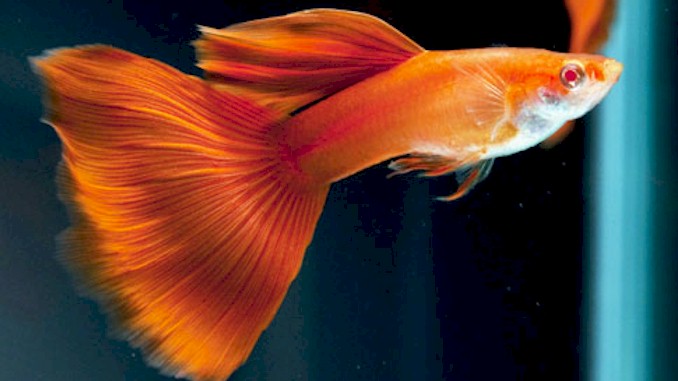

Real Red Eye Guppies are one of the rarest guppy breeds due to their unique and stunning appearance. These fish have a distinct red iris that contrasts sharply with their metallic-colored bodies, making them stand out in any aquarium. They are also known as “Albino Red Eye” Guppies and are popular with hobbyists and collectors alike. In this section, we will explore the history, characteristics, and care requirements of Real Red Eye Guppies.
History
The Real Red Eye Guppy was first bred in Germany in the early 20th century. It is believed that these guppies were created by crossing Albino Guppies with other red-colored guppy strains. The resulting offspring displayed a stunning red iris, making them a popular choice among hobbyists.
Characteristics
Real Red Eye Guppies have a metallic-colored body, ranging from silver to dark blue, with a distinct red iris. The males are generally smaller than females and have more vibrant coloration. They have a rounded tail fin and a slightly upturned mouth, giving them a distinctive appearance. These fish are typically peaceful and can be kept in community tanks with other non-aggressive species.
Care Requirements
Real Red Eye Guppies are relatively easy to care for, making them a great choice for beginners. They require a minimum tank size of 10 gallons and prefer a heavily planted aquarium with plenty of hiding places. They are tropical fish and require a water temperature of 72-82°F and a pH range of 7.0-8.0. These guppies are omnivores and will accept a variety of foods, including flakes, pellets, and frozen or live foods.
Breeding
Real Red Eye Guppies are prolific breeders and can breed in both freshwater and brackish water. Males will typically display courtship behavior, including flaring their fins and chasing females. Females can give birth to up to 50 fry per month and will typically eat their young, so a breeding box or separate tank is recommended.
Conclusion
Real Red Eye Guppies are a stunning and unique addition to any aquarium. Their striking red iris and metallic-colored bodies make them stand out among other guppy breeds. With proper care and attention, these fish can thrive and breed in a home aquarium.
Purple Moscow Guppy


Purple Moscow Guppies are a unique and striking variation of the Moscow guppy. This breed has a purple hue to its body and fins, which is caused by a specific genetic mutation. The purple coloration is most prominent in males, who also display a distinctive and elaborate tail fin. Females are less colorful, but still possess the signature purple hue.
The origin of the Purple Moscow Guppy is unclear, but they are believed to have been developed through selective breeding. It is likely that breeders first noticed the purple mutation in their Moscow guppies and began selectively breeding for this trait to create the distinct Purple Moscow Guppy breed.
The cost of Purple Moscow guppies can vary depending on a number of factors such as their availability, the breeder, and the quality of the strain. On average, you can expect to pay between $10 to $50 for a pair of Purple Moscow guppies. However, some breeders may charge more for high-quality strains that have been selectively bred for specific traits such as deeper coloration or larger fins. It’s also worth noting that shipping costs may be an additional expense if you’re purchasing Purple Moscow guppies from a breeder located in a different region or country.
Breeding Purple Moscow Guppies can be challenging, as the purple coloration is recessive and can be easily lost if not carefully maintained. Breeders must also pay close attention to water quality, nutrition, and other environmental factors to ensure the health and vitality of their guppies.
Despite the challenges, many hobbyists are drawn to the unique beauty of the Purple Moscow Guppy. These guppies make a colorful and eye-catching addition to any aquarium, and their distinctive traits and genetic mutation make them a fascinating subject for breeders and enthusiasts alike.
Lesser-Known Rare Guppy Breeds You Need to See
While the above-mentioned guppy breeds are some of the most popular and widely known among aquarium enthusiasts, there are many other rare and unique guppy breeds that deserve attention as well. Here are some lesser-known rare guppy breeds that you need to see:
Black Samurai Guppy
This guppy breed is named after its unique coloring, which consists of a black body and red fins. The black coloration is the result of a genetic mutation that causes an excess of black pigment in the skin. Black Samurai Guppies are relatively rare, but their striking appearance makes them a sought-after addition to any aquarium.


Full Platinum White Guppy
This guppy breed is a pure white color with a metallic sheen. They are bred for their white color, which is difficult to achieve due to the presence of other pigments in most guppy strains. Full Platinum White Guppies are known for their delicate and elegant appearance.
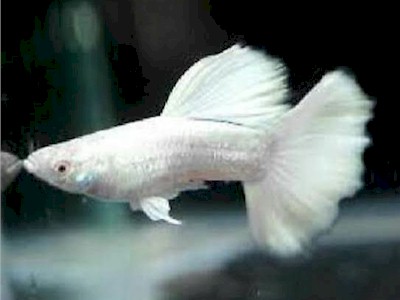

Blue Green Moscow Guppy
This guppy breed is a hybrid of the Moscow and Blue Green Guppy strains, resulting in a stunning blend of blue and green coloring. Blue Green Moscow Guppies are relatively rare, and their unique coloring makes them a popular choice among hobbyists.


Gold Cobra Guppy
This guppy breed is a variation of the Cobra Guppy, with a yellow body and black markings resembling a cobra’s hood. The Gold Cobra Guppy is a relatively new strain, but it has quickly gained popularity due to its striking appearance.


Galaxy Guppy
This guppy breed is known for its shimmering metallic scales, which resemble a galaxy of stars. Galaxy Guppies are a new strain, but they have gained popularity due to their unique appearance.


Sunset Fire Tail Guppies
This guppy breed is a variation of the Fire Tail Guppy, with orange and red coloring that creates a sunset-like effect. Sunset Fire Tail Guppies are a relatively rare strain, but their stunning coloring makes them a popular choice for aquarium enthusiasts.
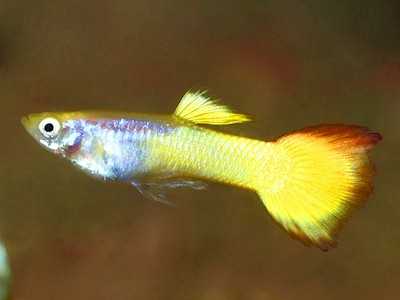

In conclusion, while the Albino Full Red Guppy, Blonde Tuxedo Guppy, Cobra Guppy, Electric Blue Guppy, Metal Lace Guppy, Half-Black Green Guppy, Dumbo Ear Guppy, Real Red Eye Guppy, Purple Moscow Guppy are all popular and widely-known guppy breeds, there are many other rare and unique guppy strains that are just as fascinating and beautiful. Whether you’re an experienced aquarium enthusiast or a beginner, exploring the world of guppy breeding can be a rewarding and enjoyable experience.
Caring for Rare Guppy Breeds: Tips and Considerations
If you’ve decided to take on the responsibility of caring for rare guppy breeds, it’s important to understand the specific needs and considerations for these unique fish. Here are some tips and considerations for properly caring for rare guppy breeds:
- Tank Size: Depending on the breed, rare guppies may require a larger tank than traditional guppies. Some breeds, like the Grass Tail Guppy or the Dumbo Ear Guppy, may require more swimming space due to their longer tails or larger bodies. It’s important to research the specific needs of each breed and provide an appropriate tank size.
- Water Quality: Like all fish, guppies require clean water to thrive. It’s important to regularly test the water parameters and perform water changes as needed. Different breeds may have different preferences for water hardness and pH levels, so it’s important to research the specific needs of each breed.
- Diet: While all guppies are omnivores, different breeds may have different dietary requirements. Some rare breeds may require a more specialized diet, such as live or frozen foods. It’s important to research the specific dietary needs of each breed and provide a varied and balanced diet.
- Breeding: If you plan on breeding rare guppy breeds, it’s important to have a good understanding of genetics and breeding practices. Some rare breeds may require specific breeding practices, such as line breeding or inbreeding, to maintain their unique characteristics.
- Tank Mates: When selecting tank mates for your rare guppies, it’s important to consider their temperament and compatibility with other fish. Some breeds may be more aggressive or territorial than others and may require specific tank mates or tank setups.
- Disease Prevention: Like all fish, guppies are susceptible to various diseases and illnesses. It’s important to practice good hygiene and quarantine new fish to prevent the spread of disease. Regular water changes and maintenance can also help prevent the buildup of harmful bacteria and parasites.
- Research: Ultimately, the most important tip for caring for rare guppy breeds is to do your research. Each breed has its own unique characteristics, needs, and considerations. By taking the time to learn about the specific needs of each breed, you can provide the best possible care for your fish and ensure their health and well-being.

